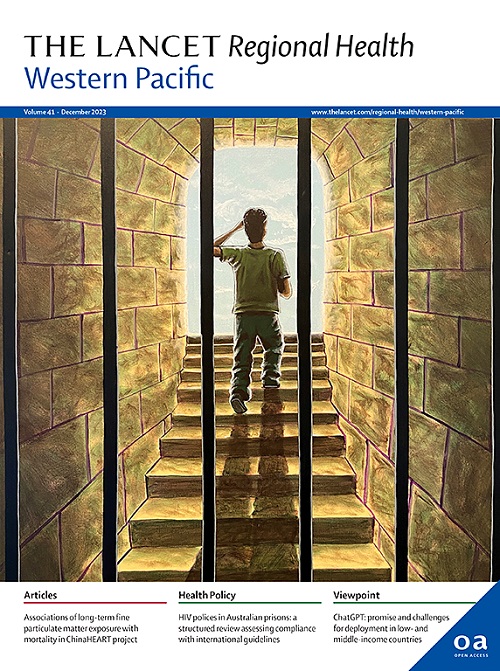Ongoing epidemic of scarlet fever in Shanghai and the emergence of M1UK lineage group A Streptococcus: a 14-year surveillance study across the COVID-19 pandemic period
IF 7.6
1区 医学
Q1 HEALTH CARE SCIENCES & SERVICES
引用次数: 0
Abstract
Background
The surge of group A Streptococcus (GAS) infections in regional countries warranted attention in the post-COVID-19 era. The resurgence of notifiable scarlet fever in China has been a public health issue since 2011. We conducted a consecutive 14-year surveillance study to analyse dynamic epidemiological profiles of scarlet fever from the perspective of epidemic trend and molecular evolution of GAS strains.
Methods
From 2011 to 2024, epidemiological data on notifiable cases of scarlet fever and 3370 GAS isolates from children with scarlet fever were analysed. Incidence rates were calculated as the mean rate per 100,000 population with 95% CIs. Whole genome sequencing was performed on 332 emm12 and 248 emm1 isolates.
Findings
From 2011 to 2024, a total of 25,539 cases of scarlet fever were reported in Shanghai. The mean incidence declined from 17.1/100,000 population (95%CI 9.7–24.3, pre-COVID-19 period) to 4.8/100,000 population (2.0–10.1, post-COVID-19 period). Children aged 4–9 years represented 85.6% of cases. Sixteen emm types were identified with predominance of emm12 (66.4%) and emm1 (29.8%). The annual proportions of emm12 and emm1 alternatively fluctuated with a cycle of six years. GAS isolates displayed >90% resistance rate to erythromycin, clindamycin, and tetracycline. The distribution of emm types, antimicrobial resistance rates and profiles, and differences in superantigen genes carried by the emm12 and emm1 isolates were similar in the pre- and post-COVID-19 periods. Phylogenetic analysis indicated 96.7% of emm12 isolates belonged to Clade II, harbouring ICE-emm12 and ΦHKU.vir. Among the emm1 isolates, the proportions of the ST1274 isolates increased from 10.5% (pre-COVID-19 period) to 73.7% (post-COVID-19 period). Four novel M1UK isolates were found in Shanghai, with distinctive characteristics of presence of speC and ssa.
Interpretation
Persistent and periodic predominance of emm12 and emm1 types was responsible for the annual epidemic of scarlet fever in Shanghai. A marked decline in the incidence of scarlet fever in the last 5 years in Shanghai may be associated with enhanced type-specific immunity among the susceptible population and enhanced infection control measures, awareness, and actions in child institutions in the post-COVID-19 era. The emergence of the M1UK isolates with some distinctive characteristics and ST1274 lineage warrants further attention and continuous surveillance in China.
Funding
Shanghai municipal three-year action plan for strengthening the construction of the public health system 2023–2025 (GWVI-2.1.2); Research project of Shanghai Minhang District Health Commission (2024MW45).
上海持续流行的猩红热和M1UK谱系A群链球菌的出现:一项为期14年的2019冠状病毒病大流行期监测研究
后covid -19时代,区域国家A群链球菌感染的激增值得关注。自2011年以来,应呈报的猩红热在中国的死灰复燃一直是一个公共卫生问题。我们开展了连续14年的监测研究,从流行趋势和GAS菌株分子进化的角度分析了猩红热的动态流行病学特征。方法对2011 - 2024年猩红热报告病例和3370例儿童猩红热分离株的流行病学资料进行分析。发病率以每10万人的平均发病率计算,ci为95%。对332株emm12和248株emm1进行了全基因组测序。结果2011年至2024年,上海市共报告猩红热25539例。平均发病率从17.1/10万人(95%CI 9.7-24.3,疫情前)降至4.8/10万人(2.0-10.1,疫情后)。4-9岁儿童占85.6%。共鉴定出16种emm型,其中emm12型(66.4%)和emm1型(29.8%)占优势。emm12和emm1的年比例以6年为周期交替波动。GAS分离株对红霉素、克林霉素和四环素的耐药率为90%。emm12和emm1分离株的emm类型分布、抗菌素耐药率和特征以及超抗原基因的差异在covid -19前后相似。系统发育分析表明,96.7%的emm12分离株属于II支,包含ICE-emm12和ΦHKU.vir。在emm1分离株中,ST1274分离株所占比例从10.5%(前期)上升至73.7%(后)。在上海发现了4株M1UK新分离株,具有明显的speC和ssa存在特征。结论emm12型和emm1型的持续和周期性优势是上海猩红热年度流行的原因。近5年来上海市猩红热发病率的显著下降可能与后covid -19时代易感人群的类型特异性免疫增强以及儿童机构感染控制措施、意识和行动的加强有关。具有一些独特特征和ST1274谱系的M1UK分离株的出现值得在中国进一步关注和持续监测。上海市《2023-2025年加强公共卫生体系建设三年行动计划》(GWVI-2.1.2);上海市闵行区卫生健康委员会科研项目(2024MW45)。
本文章由计算机程序翻译,如有差异,请以英文原文为准。
求助全文
约1分钟内获得全文
求助全文
来源期刊

The Lancet Regional Health: Western Pacific
Medicine-Pediatrics, Perinatology and Child Health
CiteScore
8.80
自引率
2.80%
发文量
305
审稿时长
11 weeks
期刊介绍:
The Lancet Regional Health – Western Pacific, a gold open access journal, is an integral part of The Lancet's global initiative advocating for healthcare quality and access worldwide. It aims to advance clinical practice and health policy in the Western Pacific region, contributing to enhanced health outcomes. The journal publishes high-quality original research shedding light on clinical practice and health policy in the region. It also includes reviews, commentaries, and opinion pieces covering diverse regional health topics, such as infectious diseases, non-communicable diseases, child and adolescent health, maternal and reproductive health, aging health, mental health, the health workforce and systems, and health policy.
 求助内容:
求助内容: 应助结果提醒方式:
应助结果提醒方式:


